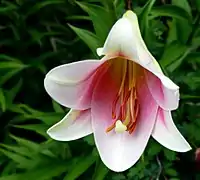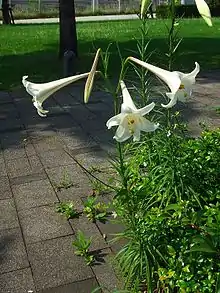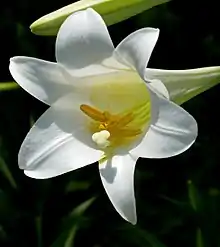Lilium longiflorum
Lilium longiflorum (Japanese: テッポウユリ, Teppōyuri), often called the Easter lily, is a plant endemic to both Taiwan and Ryukyu Islands (Japan). Lilium formosana, a closely related species from Taiwan, has been treated as a variety of Easter lily in the past. It is a stem rooting lily, growing up to 1 m (3 ft 3 in) high. It bears a number of trumpet shaped, white, fragrant, and outward facing flowers.
| Lilium longiflorum | |
|---|---|
.JPG.webp) | |
| Scientific classification | |
| Kingdom: | Plantae |
| Clade: | Tracheophytes |
| Clade: | Angiosperms |
| Clade: | Monocots |
| Order: | Liliales |
| Family: | Liliaceae |
| Subfamily: | Lilioideae |
| Tribe: | Lilieae |
| Genus: | Lilium |
| Species: | L. longiflorum |
| Binomial name | |
| Lilium longiflorum | |
Features
Plants tend to grow from about 50 cm (20 in) to 1 m (3 ft 3 in) tall. They have long oval leaves and the vein enters the horizontal direction. From April to June, the plant's flowering season, it produces pure white flowers on top of the stem. The stem has a cylindrical shape, with a diameter of about 5 cm (2.0 in).
Cultivation
A variety of it, L. longiflorum var. eximium, native to the Ryukyu Islands, is taller and more vigorous. It is extensively cultivated for cut flowers. It has irregular blooming periods in nature, and this is exploited in cultivation, allowing it to be forced for flowering at particular periods, such as Easter. However, it can be induced to flower over a much wider period. This variety is sometimes called the Bermuda lily because it has been much cultivated in Bermuda.



Use in Christian symbolism
Lilium longiflorum is known as the Easter lily because in Christianity, it is a symbol of the resurrection of Christ, which is celebrated during Eastertide.[1][2] The "lily has always been highly regarded in the Church", as Jesus Himself referenced the flower, saying "Consider the lilies how they grow: they toil not, they spin not; and yet I say unto you, that Solomon in all his glory was not arrayed like one of these" (Luke 12:27).[3] Moreover, according to pious legend, "after Jesus' death and resurrection, some of these beautiful flowers were found growing in the Garden of Gethsemane, where Jesus went to pray the night before His crucifixion. Legend has it that these flowers sprung up where drops of Jesus' sweat fell as he prayed".[4][5] In many Christian churches, the chancel is adorned with Easter lilies throughout the Paschal season.[6][7] A poem of the early 1900s titled Easter Lilies by Mrs. S.R. Allen, delineates this custom:
Somewhere while the Easter lilies
Swing their perfumed censers white,
Softened rays of sunlight falling
In lines aslant, and warm, and bright,
Shall gild the altar, nave and chancel;
Rest with tender roseate ray
On the font, enwreathed with lilies
For baptismal rites today.
Another pilgrim on the journey
From the cradle to the tomb,
Shall receive a name and blessing
While the Easter lilies bloom.
History
From the 1890s to the early 1920s, there was a thriving export trade of bulbs from Bermuda to New York. A disease affected the Bermuda lilies: this was identified by Lawrence Ogilvie. In 1903, USDA Agricultural Research Services (ARS) started to distribute disease free plant materials and seeds. The agency also started a breeding program, and released one of the first dwarf cultivars for potted-plant production in 1929.[9] Prior to USDA's effort, lily bulbs were mostly imported from Japan before the 1940s. The supply of bulbs was suddenly cut off after the attack on Pearl Harbor and Easter lilies became extremely valuable in the United States.
Currently, nearly all Easter lily bulbs used in North America are grown on coastal bottom lands in northwestern California and southwestern Oregon, particularly in the town of Smith River, California.
Chemistry
The Easter lily is a rich source of steroidal glycosides.[10] It also contains bitter principles such as 3,6′-diferuloylsucrose.[11]
Toxicity
Some Lilium species are toxic to cats. This is known to be so especially for L. longiflorum, though other Lilium and the unrelated Hemerocallis can also cause the same symptoms.[12][13][14] The true mechanism of toxicity is undetermined, but it involves damage to the renal tubular epithelium (composing the substance of the kidney and secreting, collecting, and conducting urine), which can cause acute kidney injury. Veterinary help should be sought, as a matter of urgency, for any cat that is suspected of eating any part of a lily – including licking pollen that may have brushed onto its coat.[15]
See also
References
- Collins, Cynthia (19 April 2014). "Easter Lily Tradition and History". The Guardian. Retrieved 20 April 2014.
The Easter Lily is symbolic of the resurrection of Jesus Christ. Churches of all denominations, large and small, are filled with floral arrangements of these white flowers with their trumpet-like shape on Easter morning.
- Schell, Stanley (1916). Easter Celebrations. Werner & Company. pp. 84.
We associate the lily with Easter, as pre-eminently the symbol of the Resurrection.
- Soares, Theodore Gerald (1907). The Week of Our Lord's Passion. Hope Publishing Company. p. 210. Retrieved 20 April 2014.
The lily has always been highly regarding in the Church. Jesus said "Consider the lilies." The white lily is the symbol of purity. There is a peculiar fitness in the choice of this flower as an Easter emblem. Its bulb is hidden in the earth, and waits the coming of the Easter season to spring forth and blossom. Beautiful in itself it is still more beautiful in its sacred significance.
- Hafer, Todd (2006). Easter A to Z. Hallmark Cards, Incorporated. p. 17. ISBN 9781595301079. Retrieved 20 April 2014.
Easter lilies are, perhaps, the most famous holiday flowers of all time. Sometime after Jesus' death and resurrection, some of these beautiful flowers were found growing in the Garden of Gethsemane, where Jesus went to pray the night before His crucifixion. Legend has it that these flowers sprung up where drops of Jesus' sweat fell as he prayed and became very sad about what was happening to Him.
- Swenson, Allan A. (2002). Flowers of the Bible: And How to Grow Them. Kensington Publishing Corporation. p. 182. ISBN 9780806523149. Retrieved 20 April 2014.
Christian tradition also says that lilies were found growing in the Garden of Gethsemane after Christ's agony.
- Luther League Review: 1936-1937. Luther League of America. 1936.
There were Easter lilies everywhere, on the platform in Sunday School, and the church was full of them, around the organ, along the chancel rail, inside the chancel, the whole front of the church seemed full of them.
- Franklin, Estelle Eva (1906). Home Science Magazine. Lore of the Lily: Beautiful Traditions That are Associated With the Easter Flower-Its Universality. Home Science Publishing Company. p. 550.
The Easter lily, the emblem of the Christian church for centuries, is probably more largely used for decoration of altar and shrine throughout the civilized world, in the festival of the Resurrection, than all other flowers combined.
- Ludwig, O. C.; S.R. Allen (1906). Pictures and Poems of Arkansas. Easter Lilies. Sketch Book Publishing Co. p. 103. Retrieved 20 April 2014.
- "A Brief History of Easter Lilies and the Role of the Beltsville Agricultural Research Center" (PDF). USDA-ARS.
- Munafo, JP; Gianfagna, TJ (2011). "Quantitative analysis of steroidal glycosides in different organs of Easter lily (Lilium longiflorum Thunb.) by LC-MS/MS". J Agric Food Chem. 59 (3): 995–1004. doi:10.1021/jf1036454. PMID 21235207.
- Shoyama, Yukihiro; Hatano, Koji; Nishioka, Itsuo; Yamagishi, Takashi (1987). "Phenolic glycosides from Lilium longiflorum". Phytochemistry. 26 (11): 2965. doi:10.1016/S0031-9422(00)84572-0.
- Langston CE (January 2002). "Acute renal failure caused by lily ingestion in six cats". J. Am. Vet. Med. Assoc. 220 (1): 49–52, 36. doi:10.2460/javma.2002.220.49. PMID 12680447.
- Hall J (1992). "Nephrotoxicity of Easter Lily (Lilium longiflorum) when ingested by the cat". Proc Annu Meet Am Vet Int Med. 6: 121.
- Volmer P (April 1999). "Easter lily toxicosis in cats" (PDF). Vet Med: 331.
- "Lily poisoning in cats – Vet Help Direct Blog".
Further reading
- Vidali, Luis; Hepler, Peter K. (1997). "Characterization and localization of profilin in pollen grains and tubes ofLilium longiflorum". Cell Motility and the Cytoskeleton. 36 (4): 323–338. doi:10.1002/(SICI)1097-0169(1997)36:4<323::AID-CM3>3.0.CO;2-6. ISSN 0886-1544. PMID 9096955.
- Holm, Preben Bach (1977). "Three-dimensional reconstruction of chromosome pairing during the zygotene stage of meiosis in Lilium longiflorum (thunb.)". Carlsberg Research Communications. 42 (2): 103–151. doi:10.1007/BF02906489. ISSN 0105-1938.
- Reiss, Hans-Dieter; Herth, Werner (1979). "Calcium ionophore A 23187 affects localized wall secretion infqu hoeegion of pollen tubes of Lilium longiflorum". Planta. 145 (3): 225–232. doi:10.1007/BF00454445. ISSN 0032-0935. PMID 24317727. S2CID 24097777.
External links
| Wikimedia Commons has media related to Lilium longiflorum. |